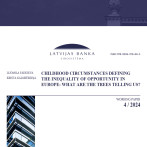Industry takes a small step back

Seasonally adjusted monthly changes in output were negative in January (–2.8%). Considering the impressive growth of the sector recorded in the last four months, a fall in the monthly rate of change was almost inevitable. Yet despite this deceleration, the annual rate of change remained quite decent at 7.8%.
Like in the previous months, growth was broadly-based, i.e. most sub-sectors reported positive annual rates. Looking at the shares of various sub-sectors in the overall output of the sector, wood industry, manufacture of metal products as well as the high technology industries were clearly the main contributors to the sectoral growth. The recent good performance of manufacturing is mostly associated with the strengthening of the external demand on account of the recovery of the EU economic growth and the rapidly improving industrial confidence indicators across the EU member states.
Construction confidence indicators of the EU member states have shown steady improvement over the last two years which is reflected also by the real volume of construction. This has a positive effect on Latvia's manufacturing sector as part of its sub-sectors have links with both domestic and export construction markets.
Sweden's "extremely warm" real estate market and the associated active construction processes act as a particularly positive catalyst. Both Latvian construction companies as well as manufacturers of building materials participate in the reshuffling of the market shares. With the revival of the local construction activities, this will give an additional push to those sectors in the second half of the year.
Latvian industrial confidence indicators as measured by the European Commission have reached a mark only recorded in individual months during the last five years and considered more or less an exception. Now they have stayed at this high level already for four months. A good thing is that this is determined by the forward-looking component of the indicator, namely, the production expectations for the coming months. This most likely means that the current leap in the volume of production is not of a temporary nature.
Capacity utilisation in manufacturing companies has also reached a post-crisis high. This could suggest two things:
- the companies utilise their own capital goods;
- the level of investment made in the previous years was low.
Renewed access to the EU structural funds should bring at least some relief to the situation this year and next year.
Low demand remains the main factor limiting growth mentioned by 39.6% of businesses at the beginning of 2017, although the percentage has decreased considerably in comparison with the previous quarters, yet the proportion of businesses pointing to shortage of labour is also increasing and has risen to 14.6%.
Even though this percentage is the highest reported after the crisis, one cannot say that the situation is dramatic. There have been times when almost 40.0% of businesses mentioned this as an important factor, e.g. from 2006 to 2007. At the moment, the shortage of labour most likely concerns only highly specialised workers or affects certain geographical areas.
As the weather conditions and the situation on the regional electricity market continued to be favourable, electricity generation reached very high levels in January. Nevertheless, this effect was offset by lower natural gas consumption (more electricity was generated by hydro power plants). As a result, the overall output of the energy sector declined by 0.4% year-on-year in January.
Textual error
«… …»






